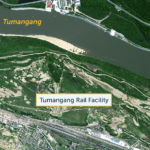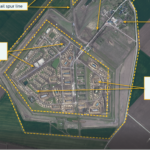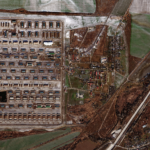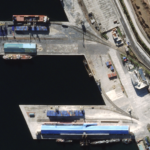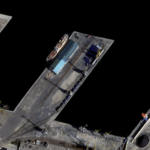May 21, 2025, by Joseph S. Bermudez Jr., Victor Cha and Jennifer Jun—
Imagery shows dramatic increases in Sino-North Korean trade at the lesser-known Wonjong-ni-Quanhe border crossing over the past few years... Overview of Wonjong-ni-Quanhe border crossing, March 21, 2025. Copyright © 2025 by Maxar Technologies. Image may not be republished without permission. Please contact imagery@csis.org. There...
April 16, 2025, by Joseph S. Bermudez Jr., Victor Cha and Jennifer Jun—
The new road bridge at the Tumangang-Khasan border constitutes more evidence of the burgeoning strategic partnership between Russia and North Korea. However, Recent satellite imagery shows the construction of the road bridge has stalled... Overview of the road bridge construction site at the Tumangang-Khasan border, March 28. 2025. Copyright…
December 18, 2024, by Joseph S. Bermudez Jr., Victor Cha and Jennifer Jun—
The ongoing high levels of rail traffic and major modernization of rail facilities at Tumangang indicates that the strategic relationship between North Korea and Russia continues to grow... Close-up of the new canopy being constructed over the modernized rail station at Tumangang Rail…
September 30, 2024, by Joseph S. Bermudez Jr., Victor Cha and Jennifer Jun—
Satellite images of the NK-China border indicate that trade between the two countries is gradually recovering to pre-pandemic levels. However, this restoration of trade was upended when unusually heavy rains struck the area in late July... Overview of the Dandong, Sinuiju, and Uiju Areas, September 8, 2024. (Copyright © 2024 by…
August 8, 2024, by Joseph S. Bermudez Jr., Victor Cha and Jennifer Jun—
Beyond Parallel reviewed satellite imagery of the Russia-North Korea border at the Tumangang-Khasan railroad crossing from early February to mid-July 2024, a few months before and a few weeks after Russian President Vladimir Putin’s visit to North Korea on June 18. The analysis between February and July 2024 shows a new railcar traffic pattern at the Russia-North Korea border.
April 15, 2024, by Joseph S. Bermudez Jr., Victor Cha and Jennifer Jun—
Recent satellite imagery reveals ongoing high-level utilization of Russia's Tikhoretsk Munitions Storage Facility, where munitions from North Korea are being stored... An overview of Tikhoretsk Munitions Storage Facility, April 7, 2024. (Copyright © 2024 by Planet)…
February 28, 2024, by Joseph S. Bermudez Jr., Victor Cha and Jennifer Jun—
Ammunition supplies have become critical in the Ukraine war. CSIS studied hundreds of commercially available satellite images since August 2023 on the continuing transfer of large quantities of munitions between North Korea and Russia... Ammunition supplies have become critical in the Ukraine war. CSIS studied hundreds of commercially available…
December 8, 2023, by Joseph S. Bermudez Jr., Victor Cha and Jennifer Jun—
Satellite images of Najin Port over the past two months show a high level of activity, suggesting that arms transfer between DPRK and Russia continue... Overview of Piers 2 and 3 at Najin (Rajin) Port, October 23, 2023. (Copyright ©…
October 17, 2023, by Joseph S. Bermudez Jr., Victor Cha and Jennifer Jun—
Latest satellite imagery of Najin Port indicates that at least six trips transporting munitions have been made by sea between North Korea and Russia... Overview of the piers at Najin (Rajin) Port, October 16, 2023. Changes observed at Pier…
October 6, 2023, by Joseph S. Bermudez Jr., Victor Cha and Jennifer Jun—
A few weeks after the Kim-Putin summit, satellite imagery show an unprecedented level of rail traffic at the DPRK-Russia border... Closeup of the Tumangang Rail Facility, October 5, 2023. Image shows an unprecedentedly high level of railcar traffic at the North Korean station at the...





